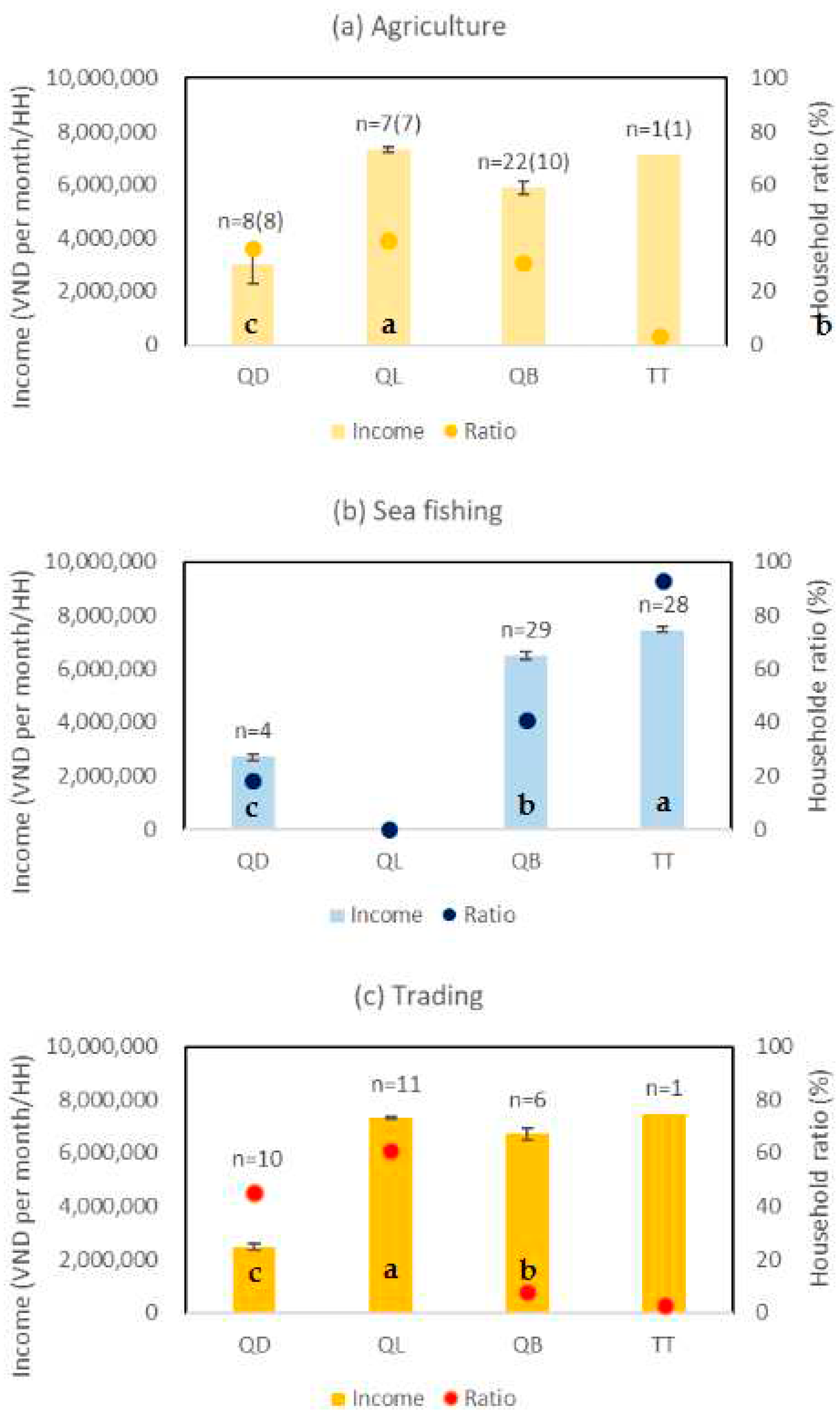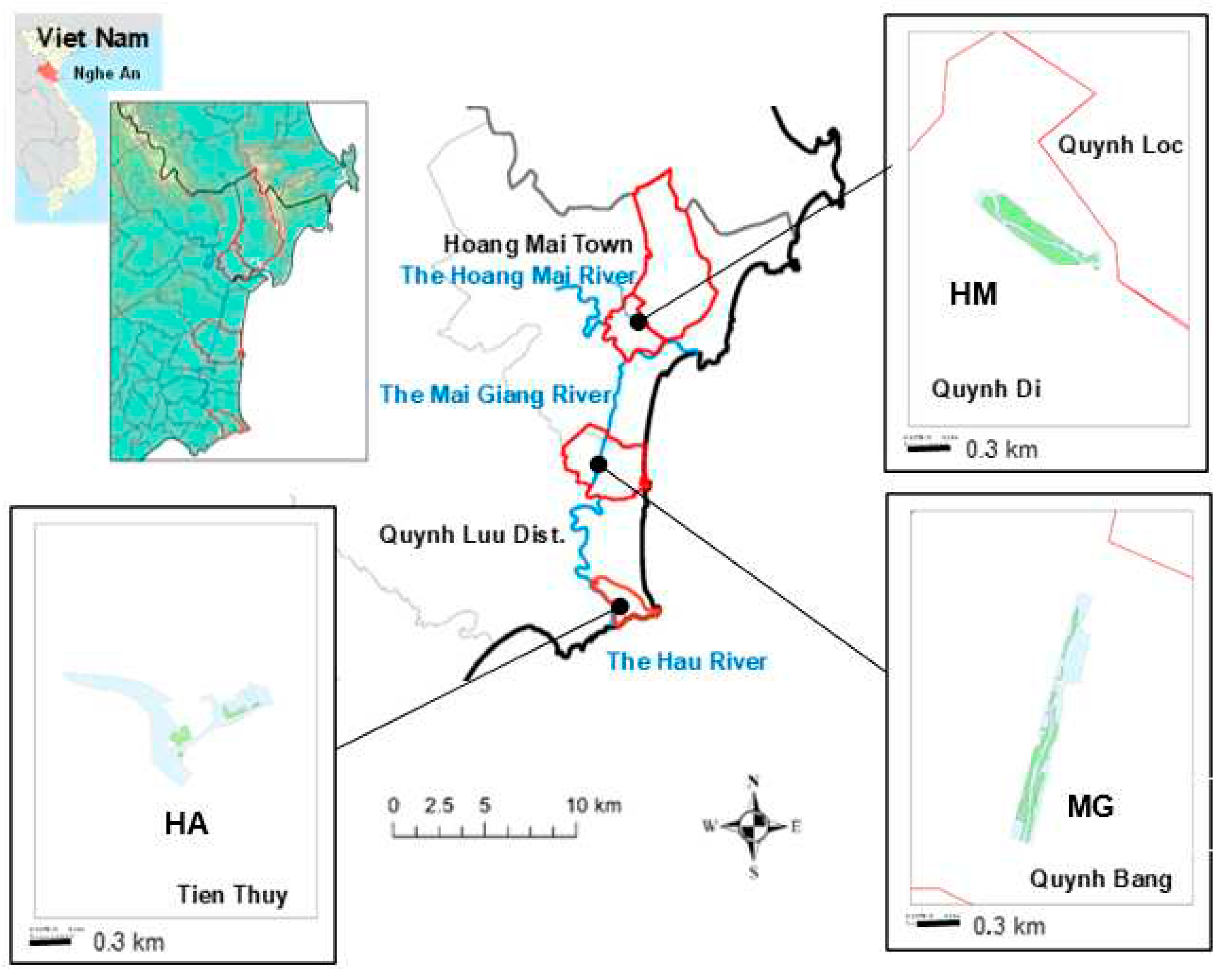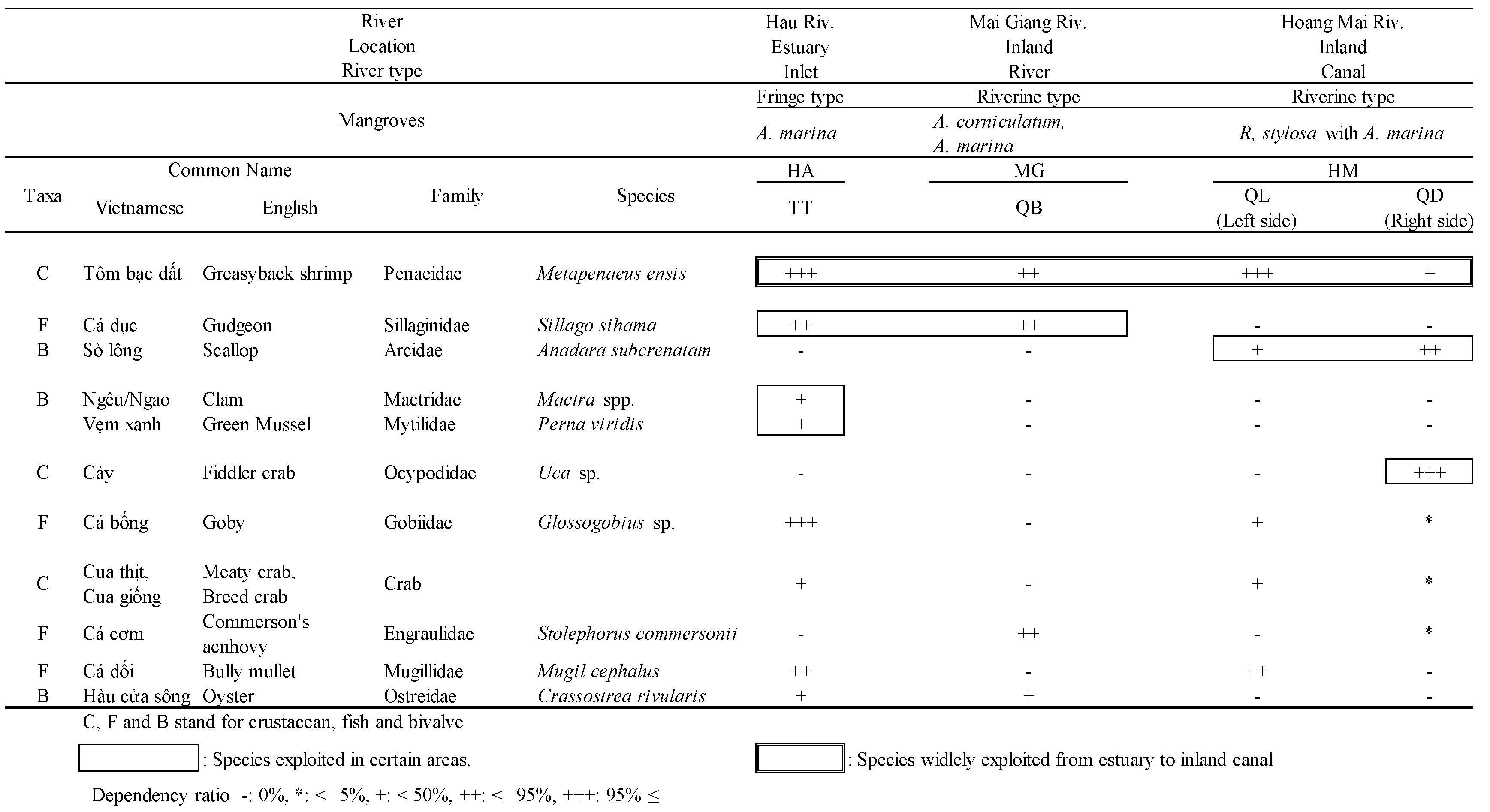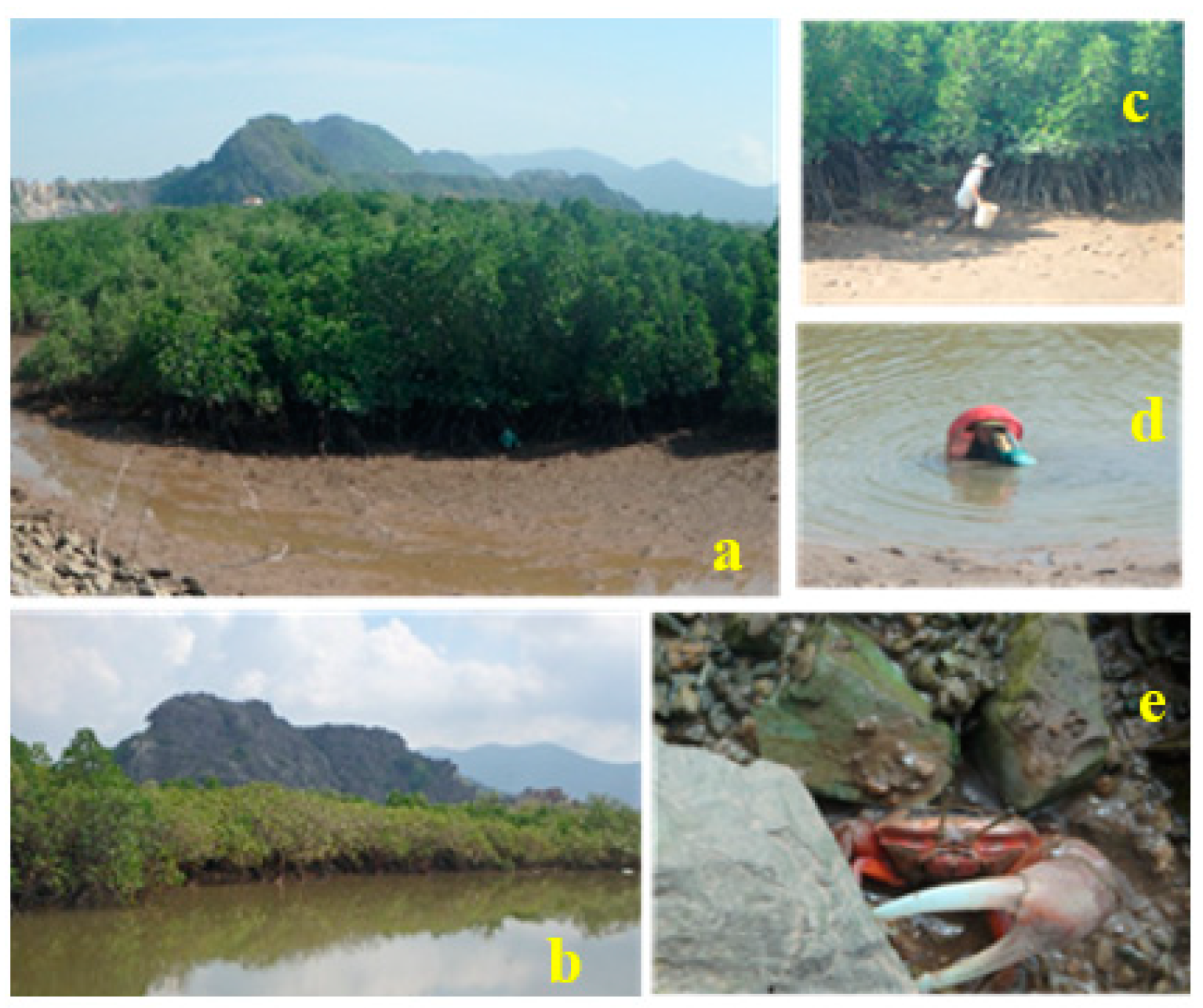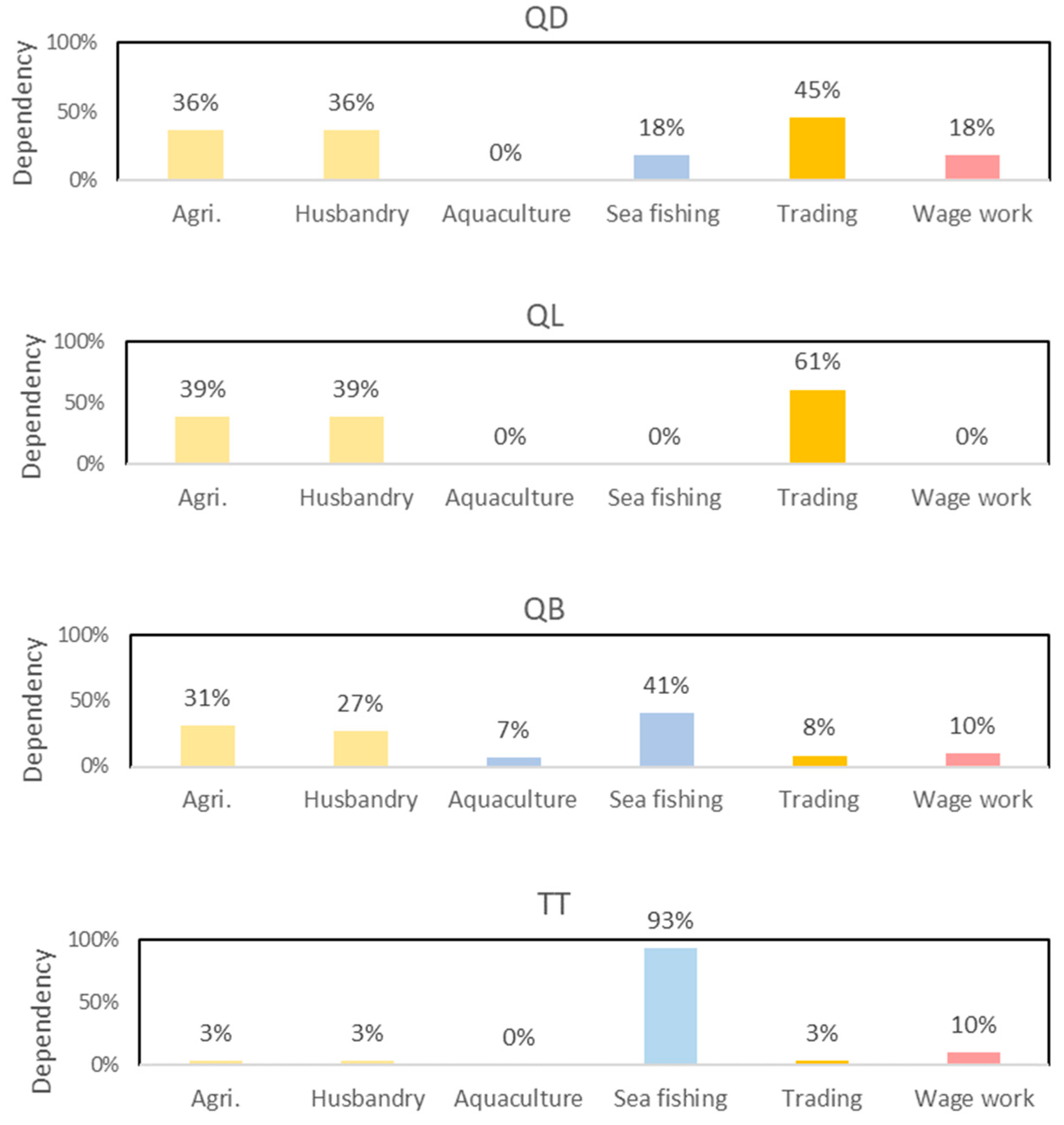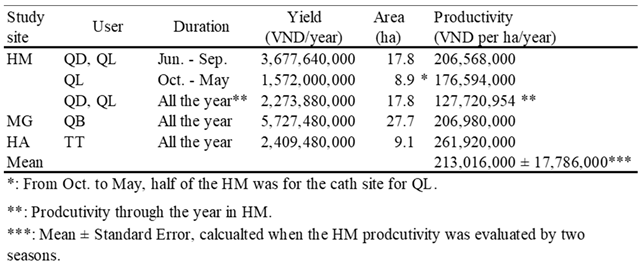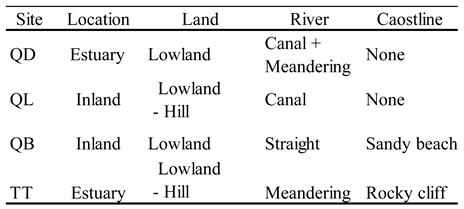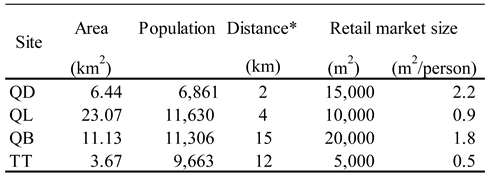1. Introduction
Mangrove ecosystems provide socio-economic benefits, which can be classified into four functions: provisioning, supporting, regulating, and cultural [
1]. Among these, provisioning of biota (e.g., fauna and flora) plays an important role in local livelihoods in coastal regions of tropical and subtropical countries [
2,
3,
4,
5,
6]. Residents near large, rural mangrove forests have been reported to be approximately 75–80 % dependent on them [
7,
8]. However, this varies widely among residents; people living relatively far from mangroves are more dependent on offshore fishing [
7], and those who possess suitable land for agriculture rely more on crop cultivation [
8], resulting in lower dependency on mangrove forests. In addition, economic growth around mangrove forests and technological development have changed occupations, especially near urban areas where residents have shifted to other occupations such as aquaculture [
9,
10,
11,
12] and external wage work [
13]. Similarly, the relative economic value of mangrove ecosystems varies widely across regions.
The coastal region of Nghe An Province, North-Central Vietnam, includes some urban areas and mangrove patches in estuaries, rivers, and inland canals. According to local governments, residents near mangrove stands still make a living fishing in mangrove ecosystems, along with various other occupations. Since this region has been developing rapidly (e.g., Decision 827/QD-TTg), urban planning based on the conservation and sustainable use of mangrove ecosystems is urgently needed. To successfully develop such plans, the income structures of mangrove-dependent areas and the influence of natural and socio-economic conditions should be clarified.
In Nghe An Province, mangrove patches are widely distributed from the fringes of estuaries to inland canals; thus, the land morphology and economic situation of the surrounding areas are heterogeneous, providing various occupational opportunities to residents. The landscape ecological approach, which is frequently used to understand landscape patterns, has been applied for land use planning [
14]. In terms of mangrove-related planning, this method has been used in many cases [
15,
16,
17,
18] and could be appropriate for clarifying the relationship between natural and socio-economic landscape components and livelihoods.
Based on above, the present study aims to elucidate (1) the fisheries catch in mangrove ecosystems and its productivity, (2) the total income, its sources, and its relationship to landscape components in the Hau and Hoang Mai river estuaries of the Nghe An coastal region, North-Central Vietnam, and (3), based on the results of (1) and (2), the ecological services mangrove ecosystems provide for local livelihoods.
2. Materials and Methods
2.1. Study site
The study area was located in the northern part of the Nghe An coastal region and included Hoang Mai town and Quynh Luu district. Herein, a town is characterised by a higher economic level than a district. The site contained the Hoang Mai and Hau rivers, which flow into Tonkin Bay, as well as the Mai Giang River, which flows from the Hoang Mai to the Hau River (
Figure 1). The town of Hoang Mai consists of five urban wards (hereinafter simply referred to as wards) and five suburban communes (hereinafter simply referred to as communes) with a population of 115,295 as of 2019. In comparison, Quynh Luu district includes one township and thirty-two communes with a population of 278,671 as of 2019 [
19].
Mangrove stands are scattered across the three above-mentioned rivers: one stand of each river was selected as a study site: the Hoang Mai River in the Quynh Di ward, Hoang Mai town, referred to as HM (19°14'36"N, 105°43'52"E); the Mai Giang River in the Quynh Bang commune, Quynh Luu district, termed MG (19°10'39"N, 105°42'30"E); and the Hau River in the Tien Thuy commune, Quynh Luu district, referred to as HA (19°07'05"N, 105°43'22"E) (
Figure 1). HM was the catch site of residents of Phu Loi 1 and 2, the Quynh Di (QD) ward and Village 2, the Quynh Loc (QL) commune. MG and HA were the catch sites of residents of Mai Giang 1 and 2, the Quynh Bang (QB) commune, Son Hai, the Tien Thuy (TT) commune.
According to
in-situ observations, the dominant mangrove species in the study area were
Rhizophora stylosa and
Avicennia maria. Additionally,
Aegiceras corniculatum partially occurred in fluvial sand bars. Species were identified according to UNEP (2008) [
20].
The region is influenced by the northeast monsoon and characterised by a mean annual temperature of 24.6 ℃, with June being the warmest month (30.1 ℃) and January the coldest (18.3 ℃). Mean annual rainfall is 1,753 mm per year, with a minimum mean precipitation in March (48 mm) and maximum mean precipitation in September (445 mm) [
21].
2.2. Income, mangrove ecosystem productivity and catch
Interviews of the heads of households living in QD, QL, QB, and TT were conducted by well-trained interviewers from 12th–21st February 2020 and 20–25th June 2020. Respondents from 22 out of 22 households, 18 out of 18 households, 71 out of 85 households, and 30 out of 31 households of QD, QL, QB, and TT participated, respectively. The sample size was determined according to Yamane (1967) [
22] using Eq. (1), with an allowable error (
e) of less than 0.05 for each user group.
where n is the sample size,
N is the total number of households, and
e is allowable error (0.05).
The interview questions included: (1) the mean household income from mangrove ecosystems per month (MIFME) in Vietnamese dong (VND) (rounded to less than five significant digits), (2) the species caught in mangroves, (3) the mean income from other sources per month (MIFOS) (rounded to the same significant digits as MIFME), and (4) their income sources. Subsequently, we used the data on income and catch sites (
Figure 1) to estimate the productivity of mangrove ecosystems.
Catch species were identified by referring to RIMF (2009) for bivalves [
23], Rosenberg (2001), Viet and Sakuramoto (2013), and Samphan et al. (2016) for crustaceans [
24,
25,
26], and Hau and Thuy (2014) for fish [
27].
2.3. Landscape components
Landscape features of the study areas were analysed using Geographical Information System (GIS) software (ArcGIS version 10.8.2) using an overlay of a coastline and provincial borders (obtained from the United Nations Office for the Coordination of Humanitarian Affairs), river and ward/commune borders (obtained from Google Earth), and contour (obtained from the East West Management Institute) maps. Subsequently, location, land, river, and coastline were categorised into estuary or inland, lowland or hills, meandering or straight (including canals), and sandy beach or rocky cliff, respectively, to understand the natural landscape components of QD, QL, QB, and TT.
In terms of socio-economic components, information on the area, population, and location of retail markets of the four communes was obtained. The first two components were taken from the statistical yearbook of Nghe An, Vietnam [
19], and the latter was obtained from interviews of local governments combined with
in-situ observations. Subsequently, the area of retail markets and their distances to the centre (defined as reaching from the ward/commune governmental office to the town/district governmental office) were measured using Google Earth.
2.4. Relationship between income structure and landscape components
After understanding the income structure of the mangrove stand user groups (i.e., their incomes from different sources), selecting the major income sources, multiple regression analysis with natural/socio-economic landscape component variables was carried out to determine which landscape components affected the income structure. In the process of obtaining the equations, correlation matrixes among the natural landscape component variables were calculated to select explanatory variables to explain the response variables of the incomes.
3. Results
3.1. Income from mangrove ecosystems and other sources
The MIFME varied from 2,920,000 VND per month/HH (equivalent to 117 USD per month/HH) in QD to 7,2800,000 VND per month/HH (equivalent to 291 USD per month/HH) in QL, with that of QD being significantly lower than that of the other places (
p < 0.01). The MIFOS showed a similar tendency, varying from 2,720,00 VND per month/HH (equivalent to 109 USD per month/HH) in QD to 7,420,000 VND per month/HH (equivalent to 297 USD per month/HH) in TT. The MIFOS of QL was not significantly lower than that of TT, but both were significantly higher than those of QB and QD (
p < 0.01). Lastly, the MIFOS of QB was significantly higher than that of QD (
p < 0.01). The dependence on mangrove ecosystems ranged from 47.3 % in TT to 52.0 % in QB (
Table 1).
3.2. Productivity of mangrove ecosystems
The mean productivity of the mangrove ecosystems in the study area was 213,016,000 VND per ha/year (equivalent to 8,520 USD per ha/year) (
Table 2). HA had the highest productivity with 261,920,000 VND per ha/year (equivalent to 10,476.8 USD per ha/year). In turn, HM showed seasonal variations in productivity owing to households in QD not fishing between October and May. Productivity of HM was 206,568,000 VND per ha/year (equivalent to 8,263 USD per ha/year) from June to September, and 176,594,000 VND per ha/year (equivalent to 7,064 USD per ha/year) during the remaining months, resulting from use of half of the catch sites. The annual productivity of the entire area of HM was 127,720,954 VND per ha/year (equivalent to 5,109 USD per ha/year). The productivity of MG was close to that of HM between June and September, with 206,980,000 VND per ha/year (equivalent to 8,273 USD per ha/year).
3.3. Longitudinal distribution patterns of catch
Figure 2 shows a schematic of the longitudinal distribution patterns of fisheries catch. Penaeid (
Metapenaeus ensis) was the primary catch collected across the Hoang Mai and Hau River regions. Scallops (
Anadara subcrenatam) were caught in parts of the Hoang Mai River, and gudgeon (
Sillago sihama) was caught between the Mai Giang and Hau River. Fiddler crabs (
Uca sp.) were the primary catch of QD households, while others did not exploit it (
Figure 3).
3.4. Income structure
Figure 4 illustrates the percentage of households by income source. Agriculture, including husbandry and trading, was the main source of income in QD and QL, while sea fishing was the main source in QB and TT. Approximately 30 % of households in QB engaged in agriculture, whereas almost all households (93 %) in TT engaged in sea fishing. Additionally, wage work was a major income source in QD (18 %) but not in other areas.
3.5. Landscape patterns
QD and QB were located in lowlands, their elevations were 4 m – 23 m and 4 m – 8 m, respectively. QL and TT were located in lowlands and hills; the former ranged from 4 to 214 m in elevation, while the latter sharply rose from 4 m to 83 m. Additionally, the types of rivers flowing in the study area differed. QD has been developed around the Hoang Mai River estuary, containing meandering rivers and canals, while QL was located inland, thus possessing only canals. QB and TT both belonged to the Quynh Luu district, but the former was located in the middle reach of the Mai Giang River, whose water course is straight, while the latter was located in the lowest reaches of the Mai Giang River (i.e., located in the Hau River estuary). QD and QL did not possess coastline, while QB and TT did (
Figure 1;
Table 3).
Table 4 shows the socio-economic landscape components. QD and QL were relatively close to the town centre (2–4 km), while QB and TT were located more than 10 km from the centre (12–15 km). QL extended into the hills and QB was located in the plains, and their land area and population were greater than that of the others. The retail market size ranged from 5,000 m
2 to 20,000 m
2 (from 0.5 m
2/person to 2.2 m
2/person).
3.6. Relationship between income structure and landscape components
The households in QL earned the most from agriculture, followed by those of QB, and the lowest agricultural income was drawn by those in QD (
p < 0.05). TT was not included here because only one household was engaged in an agricultural occupation. In terms of income from sea fishing, the households in TT earned the highest income, followed by those in QB, with the lowest sea fishing income being drawn by those in QD (
p < 0.01). Households in QL did not engage in sea fishing (
Figure 4).
The income from agriculture, sea fishing, and trading was explained by Eqs. (2), (3), and (4) which were derived from multiple regression analysis and whose coefficients of determination (R2) were 0.5231 (p < 0.001), 0.7973 (p < 0.001), and 0.9770 (p < 0.001), respectively.
In terms of Eq. (2), the variables hill and meandering river correlated with lowland and straight river/canal, respectively (both
r is -1.000), thus, these variables were not selected. Since the variables inland and estuary correlated with sandy beach (
r = 1.000 and
r = -1.000, respectively), these were eliminated for Eq. (3). The same procedures were followed for Eq. (4) and its socio-economic landscape component variables (
Table 4), resulting in elimination of the variables of area and market area per person, because of correlation with that of market size (
r = -0.827 and
r = 0.758, respectively).
(R2 = 0.9770, p < 0.001)
where IFA, IFSF, and IFT represent income from agriculture and husbandry, sea fishing, and trading, respectively. The asterisks next to the figures indicate the significance of the partial regression coefficients, where * and ** are p < 0.05 and p < 0.01, respectively. R2 is the coefficient of determination.
Equation (2) indicated that lowlands produced fewer crops, but that straight nearby water courses increased production (standard partial regression coefficient (ß) = -0.3891, p < 0.01; ß = 0.5591, p < 0.01, respectively). Equation (3) implied that rocky cliffs contributed more to the productivity of sea fishing than sandy beaches did (ß = 1.4834, p < 0.01; ß = 1.8383, p < 0.01, respectively). Equation (4) demonstrated that income from trading was strongly affected by the population in the respective ward or commune, which increased income from trading, whereas retail market size was a negative factor in reducing trading income (ß = 0.7796, p < 0.01; ß = -0.2916, p < 0.01, respectively).
4. Discussion
4.1. Mangrove ecosystem productivity and catch
The mean mangrove productivity of the study area was 8,520 USD per ha/year, which is less than the global average of 28,662 USD per ha/year [
6]. However, it contributed to local household livelihoods, with approximately 50 % of their income being derived from the mangrove ecosystems. Penaeid (
M. ensis), a commercial species commonly found in mangrove forests in Vietnam [
25] whose biomass has been reported to be dependent on mangrove ecosystems [
28] was widely collected between the Hoang Mai and Hau River and was the dominant catch for households across the study area, except for those of QD, which mainly exploited fiddler crabs (
Uca sp.). Notably, in HM, fiddler crabs were caught for a limited time, decreasing its yearly production to
5,109 USD per ha/year. This could be attributed to seasonal growth patterns that depend on the temperature regime [
29].
4.2. Income structure and its relationship with landscape components
The income structure pattern in the study area was not homogenous. TT had a high percentage of households that engaged in sea fishing (93 %). Similarly, sea fishing was the major income source in QB (41 %), but agriculture and husbandry were also important, with 31 % and 27 % of households dependent on them, respectively. TT had a rocky coastline, which resulted in a 20 % higher income from sea fishing compared to areas with sandy beaches, as revealed by the multiple regression analysis (ß = 1.8383, p < 0.01; ß = 1.4834, p < 0.01, respectively).
Agriculture and husbandry were the second major sources of income for QD, QL, and QB. Among the three, QL had the highest income, followed by QB and QD. Lowland was found to be unsuitable for agriculture and husbandry, thus reducing incomes. However, when the surrounding rivers flowed straight, including straight canals, it increased the total income from agriculture (ß = -0.3891; p < 0.01; ß = 0.5591; p < 0.01, respectively).
Trading was the major income source for QL and QD, with 61 % and 45 % of households engaging in trading, respectively. According to residents, their trading was community-based, that is, transactions were performed inside their wards or communes; thus, their population was the major socio-economic factor increasing the income from trading, while distance to the centre increased it (ß = 0.7796; p < 0.01; ß = 0.2585; p < 0.01 for QL and QD, respectively). In contrast, retail market size acted as a negative factor (ß = -0.2916; p < 0.01), which could be due to an increase in competitors.
4.3. Evaluation of mangrove ecosystems in the study area
The productivity of HA was the highest with 8,520 USD per ha/year among the three study sites. However, it solely consisted of pioneer species such as
A. marina [
30,
31], which are frequently disturbed owing to their location at the fringes of the estuary. The MIFME of households in TT, the user group of HA, did not differ from those in QL and QB and was higher than the MIFME of those in QD. The productivity of HA could be fractalated due to frequent disturbance by storms; thus, households engaged in sea fishing, were taking advantage of the rocky cliffs.
The households in QD were more dependent on HM mangrove stands (51.8 %), and those of QB were more dependent on those in MG (52.0 %) than the other two communes. At 5,109 USD per ha/year, the productivity of HM was the lowest, but it played an important role in the livelihood of households in QD owing to a landscape unsuitable for both agriculture and sea fishing. From an ecological perspective, HM, which consisted of
R. stylosa and
A. marina, could be in the late succession stage and more stable than HA due to its location in an inland canal. Nguyen et al. (2015) [
32] reported that the area of
Rhizophora in the Can Gio biosphere in Vietnam continuously increased, whereas that of
Avicennia decreased from 1996 to 2010 despite protection.
The mangrove stands at MG grew in a river frequently disturbed by floods; thus, the dominant species were pioneers of
A. marina and
Aegiceras corniculatum [
31,
33], yet their productivity was the second highest (8,273 USD per ha/year). QB, which was the user group of MG, was located in an area unsuitable for sea fishing due to the presence of sandy beaches, increasing their dependency on the mangrove ecosystem.
In this study, mangrove ecosystems were evaluated based on their ecological aspects and the income structures of the surrounding areas attributed to natural and socio-economic landscape components. The methodology presented in this study could predict which occupations potentially provide higher incomes in the areas; thus, mangrove ecosystem importance can be evaluated through consideration of local livelihoods in the future. The approach used in the present study can be generalised to mangroves forests near urban areas.
Acknowledgements
This research was supported by a scientific project of the Vietnam Ministry of Education and Training, code B2022-TDV-08. Special thanks to Mr. Shiro Matsunami of the NPO Ecology and Regional Culture Studies Association for mapping the study area using GIS software and colleagues of the ecology team, School of Agriculture and Natural Resources, Vinh University for their technical support. We would like to thank Editage (
www.editage.com) for English language editing.
Figure 5.
Incomes by sources: crop agriculture with husbandry, sea fishing and trading. Alphabets in the bars indicate differences of incomes from (a) agriculture with husbandry, (b) sea fishing, and (c) trading, whose p values are < 0.05, < 0.01, and < 0.05, respectively. (ANOVA, Tukey – Kramer test). Number in parenthesis in (a) means numbers of household engaging in husbandry.
Figure 5.
Incomes by sources: crop agriculture with husbandry, sea fishing and trading. Alphabets in the bars indicate differences of incomes from (a) agriculture with husbandry, (b) sea fishing, and (c) trading, whose p values are < 0.05, < 0.01, and < 0.05, respectively. (ANOVA, Tukey – Kramer test). Number in parenthesis in (a) means numbers of household engaging in husbandry.
References
- The Millennium Ecosystem Assessment Report (2005) A Report Prepared for the National Climate Assessment. In: Assessment of Climate Change in the Southwest United States. Island Press, Washington DC.
- Ewel, C.K.; Twilley, R.R.; Ong, E.J. (1998) Different kinds of forests provide different goods and services. Global Ecology and Biogeography Letters 7: 83-94. [CrossRef]
- Barbier, B.E. (2000) Valuing the environment as input: review of applications to mangrove-fishery linkages. Ecological Economics 35: 47–61. [CrossRef]
- UNEP (2006) Marine and coastal ecosystems and human well-being: A synthesis report based on the findings of the Millennium Ecosystem Assessment.
- Kathiresan, K. (2012) Importance of mangrove ecosystem. International Journal of Marine Science 2(10): 70-89.
- Bimrah, K.; Dasgupta, R.; Hashimoto, S.; Saizen, I.; Dhyani, S. (2022) Ecosystem services of mangroves: a systematic review and synthesis of contemporary scientific literature. Sustainability 14, 12051. [CrossRef]
- Hussin, A.S.; Badola, R. (2010) Valuing mangrove benefits: contribution of mangrove forests to local livelihoods in Bhitarkanika Conservation Area, East Coast of India. Wetlands Ecol Manage (2010) 18:321–331. [CrossRef]
- Mallick, B.; Priodarshini, R.; Kimengsi, N.J.; Biswas, B.; Hausmann, E.A.; Islam, S.; Huq, S.; Vogt, J. (2021) Livelihoods dependence on mangrove ecosystems: empirical evidence from the Sundarbans. Current Research in Environmental Sustainability 3. [CrossRef]
- Tran, T.T.H.; Han, V.D.; Simon, R.B. (2012) Mangrove conservation or shrimp farmer’s livelihood? The devolution of forest management and benefit sharing in the Mekong Delta, Vietnam. Ocean & Coastal Management 69:185-193. [CrossRef]
- Orchard, E.S.; Stringe,r C.L.; Quinn, H.C. (2015) Mangrove system dynamics in Southeast Asia: linking livelihoods and ecosystem services in Vietnam. Reg Environ Change online. [CrossRef]
- Takahashi, K.; Tran, T.T.; Nguyen H.H.; Nguyen, T.T.H. (2020) Species composition, habitat structure and sedimentation in a Sonneratia caseolaris stand at the Lam River estuary, Vietnam. Fundam Appl Agric 5(2): 157–166. [CrossRef]
- Takahashi, K.; Tan, T.T. (2022) Study on stand structure of secondary mangrove forest: Sonneratia caseolaris - Aegiceras corntculaturn stand for introducing silvofishery systems to shrimp culture ponds. In: Nguyen TA, Hens L (eds): global changes and sustainable development in Asian emerging market economies 2, pp. 495-504. [CrossRef]
- Barbier, B.E. (2006) Mangrove dependency and the livelihoods of coastal communities in Thailand. In: Hoanh TC, Tuong PT, J.W. Gowing WJ, Hardy B (eds): environment and livelihoods in tropical coastal zones, managing agriculture–fishery–aquaculture conflicts. International Rice Research Institute (IRRI), Metro Manila, Philippines, pp 126-129.
- Turner, G.M. (1989) Landscape ecology: The effect of pattern on process. Annu. Rev. Ecol. Syst. 20:171-97. [CrossRef]
- Nguyen, A.T.; Nguyen, X.H.; Pham, D.H.; Nguyen, S.T. (2008) Landscape ecological planning based on change analysis: A case study of mangrove restoration in Phu Long - Gia Luan area, Cat Ba Archipelago. VNU Journal of Science, Earth Sciences 24(3): 133-144.
- Masnavi, R.M.; Amani, N.; Ahmadzadeh, A. (2016) Ecological landscape planning and design strategies for mangrove communities (Hara Forests) in South-Pars special economic energy zone, Asalouyeh- Iran. Environment and Natural Resources Research 6(3): 44-57. [CrossRef]
- Ambarita, S.T.P.; Basyuni, M.; Sulistyono N.; Wati, R.; Fitri, A.; Slamet, B.; Balke, T.; Bunting, P.; Munir, E. (2018) Landscape planning and economic valuation of mangrove ecotourism using GIS and Google Earth image. Journal of Theoretical and Applied Information Technology 96(19): 6306-6317.
- Alemu, I J.B.; Richards, R.D.; Gaw, Y.L.; Masonudi, M.; Nathan, Y.; Friess, A.D. (2021) Identifying spatial patterns and interactions among multiple ecosystem services in an urban mangrove landscape. Ecological Indicators 121, 107042. [CrossRef]
- Vietnam General Statistics Office (2021) Statistical year book of Nghe An, Vietnam 2021. Statistical Publishing house.
- UNEP (2008) National report on mangroves in South China Sea Vietnam. In: National reports on mangroves in the South China Sea. UNEP/GEF/SCS Technical Publication No. 14.
- Giang, P.Q.; Toshiki, K.; Sakata, M.; Kunikane, S.; Vinh, T.Q. (2014) Modelling climate change impacts on the seasonality of water resources in the upper Ca River watershed in Southeast Asia. Sci World J. [CrossRef]
- Yamane, T. (1967) Statistics: an introductory analysis, 2nd ed. Harper and Row, NY.
- Research Institute for Marine Fisheries (2009) Bivalve mollusk resources (Bivalvia) in some typical mangrove areas along the coast of Vietnam. Seafood Research Institute, Ministry of Agriculture and Rural Development, Vietnam. http://www.rimf.org.vn/bantin/chitiet/NguonloidongvatthanmemhaimanhvoBIVALVIAtaimotsovungrungngapmandienhinhvenbienVietNam.
- Rosenberg, S.M. (2001) The systematics and taxonomy of fiddler crabs: a phylogeny of the genus Uca. Journal of Crustacean Biology 21(3): 839–869. [CrossRef]
- Viet, T.V.; Sakuramoto, K. (2013) Population structure and fishing of the greasyback shrimp (Metapenaeus ensis, De Haan, 1844) by bag net in a coastal river of the Mekong Delta, Vietnam. International Journal of Fisheries and Aquaculture 5(5):83-91.
- Samphan, P.; Sukree, H.; Reunchai, T. (2016) Population dynamics of the greasyback shrimp (Metapenaeus ensis, De Haan,1844) in the Songkhla Lake, Songkhla Province, Thailand. Journal of Agricultural Technology 12(1):75-89.
- Hau, T.D.; Thuy, T.T. (2014) Fish Diversity and Fishery Status in the Ba Che and Tien Yen Rivers, northern Vietnam, with Consideration on Factors Causing Recent Decline of Fishery Products. Kuroshio Science7(2): 113−122.
- de Graaf, G.J.; Xuan, T.T. (1998) Extensive shrimp farming, mangrove clearance and marine fisheries in the southern provinces of Vietnam. Mang Salt Marsh 2: 159-166. [CrossRef]
- Mokhtari, M.; Savari, A.; Rezai, H.; Kochanian, P.; Bitaab, A. (2007) Population ecology of fiddler crab, Uca lactea annulipes (Decapoda: Ocypodidae) in Sirik mangrove estuary, Iran. Estuarine, Coastal and Shelf Science 76: 273-281. [CrossRef]
- Balke, T.; Bouma, J.T.; Horstman, M.E.; Webb, L.E.; Erftemeijer, L.A.P.; Herman, M.J.P. (2011) Windows of opportunity: thresholds to mangrove seedling establishment on tidal flats. Mar Ecol Prog Ser 440: 1–9.
- Feng, X.; Li. G.; Xu, S.; Wu, W.; Chen, Q.; Shao, S.; Liu, M.; Wang, N.; Zhong, C.; He, Z.; Shi, S. (2021) Genomic insights into molecular adaptation to intertidal environments in the mangrove Aegiceras corniculatum. New Phytol 231(6): 2346-2358. [CrossRef]
- Nguyen, V.L.; Tateishi, R.; Nguyen, T.H. (2015) Analysis of an Impact of Succession in Mangrove Forest Association Using Remote Sensing and GIS Technology. Journal of Geography and Geology 7(1): 106-116. [CrossRef]
- Thatoi, H.; Samantaray, D.; Das, K.S. (2016) The genus Avicennia, a pioneer group of dominant mangrove plant species with potential medicinal values: a review, Frontiers in Life Science, 9:4, 267-291. [CrossRef]
|
Disclaimer/Publisher’s Note: The statements, opinions and data contained in all publications are solely those of the individual author(s) and contributor(s) and not of MDPI and/or the editor(s). MDPI and/or the editor(s) disclaim responsibility for any injury to people or property resulting from any ideas, methods, instructions or products referred to in the content. |
© 2023 by the authors. Licensee MDPI, Basel, Switzerland. This article is an open access article distributed under the terms and conditions of the Creative Commons Attribution (CC BY) license (http://creativecommons.org/licenses/by/4.0/).
